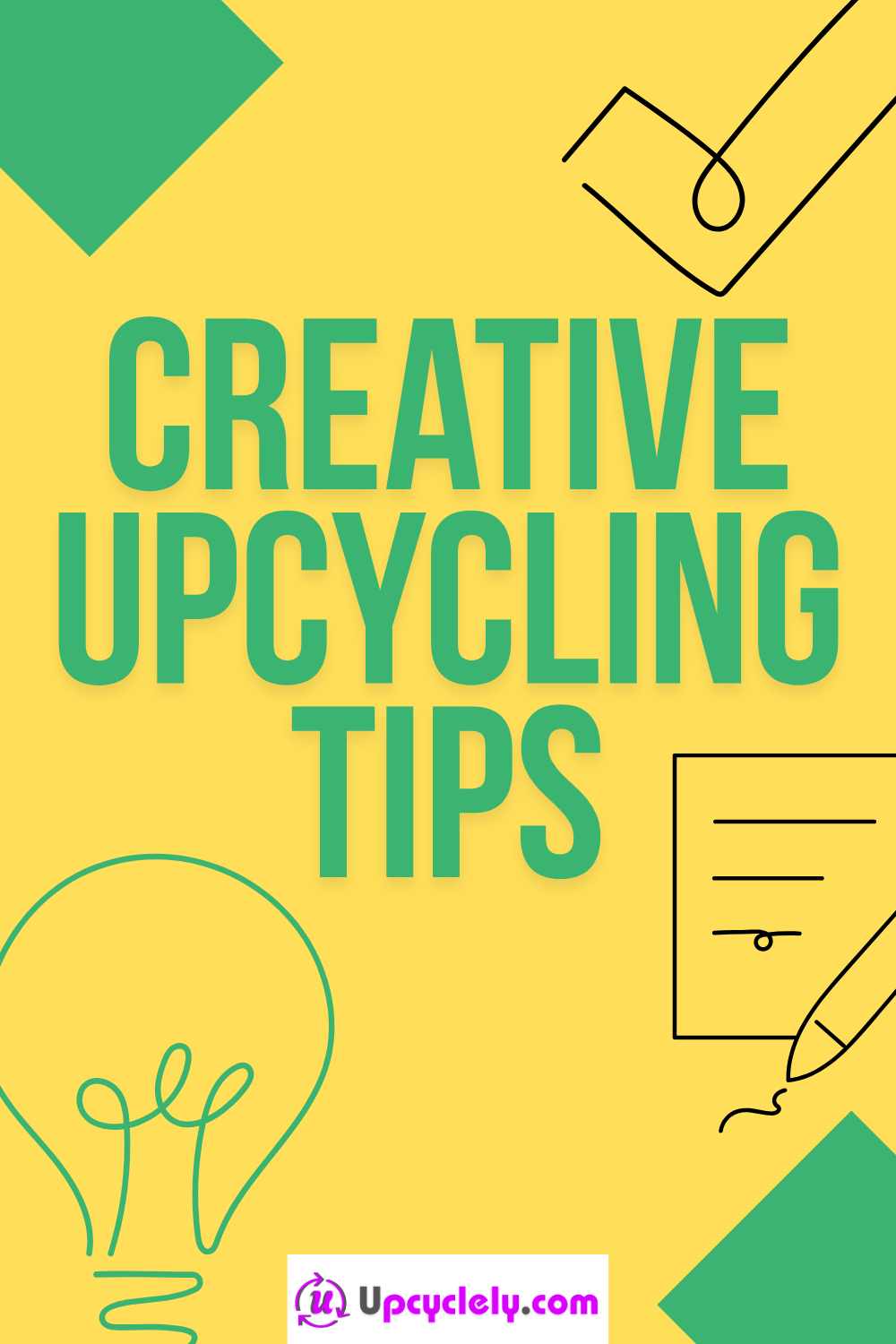Creative Upcycling Tips to Transform Your Trash into Treasure
In a world increasingly aware of the environmental impact of waste, upcycling has emerged as a vibrant and innovative solution to breathe new life into items that would otherwise be discarded.
Imagine transforming an old wooden pallet into a stunning coffee table, or repurposing glass jars into chic storage solutions for your home.
Upcycling not only helps reduce landfill waste but also allows you to express your creativity and personal style in ways that store-bought items simply cannot.
In this blog post, we’ll unveil 10 creative upcycling tips that will inspire you to see the potential in your trash and turn it into treasure.
Whether you’re a seasoned DIY enthusiast or just starting out, these ideas will spark your imagination and empower you to embark on your own journey of eco-friendly transformations. Get ready to roll up your sleeves and discover the art of upcycling!
Essential Tools and Materials for Upcycling Projects
When embarking on your upcycling journey, having the right tools and materials can make all the difference between a simple project and an extraordinary transformation. Here’s a breakdown of essential items to equip yourself with, ensuring your creative vision becomes a reality.
Basic Hand Tools:
A solid set of hand tools is crucial for disassembling and reconstructing furniture or other items. A good quality screwdriver set, pliers, a hammer, and a utility knife are must-haves. These tools will help you take apart old furniture or carefully modify materials for your projects.
Measuring and Marking Tools:
Precision is key in upcycling. A measuring tape, ruler, and carpenter’s square will allow you to take accurate measurements, ensuring your finished product looks polished and professional. Don’t forget a good quality pencil or chalk for marking your materials!
Adhesives and Fasteners:
Depending on your project, you may need a variety of adhesives. Wood glue is ideal for furniture projects, while fabric glue is perfect for textile-based upcycles. Additionally, having a staple gun, screws, and nails on hand will enable you to secure pieces together effectively.
Paints and Finishes:
A fresh coat of paint can breathe new life into worn-out furniture. Choose eco-friendly paints, stains, or sealants to not only enhance the look of your project but also to reduce your environmental impact. Consider chalk paint for a trendy, matte finish or spray paint for a quick and even application.
Fabric and Textiles:
If your upcycling project involves soft goods, such as reupholstering chairs or creating new cushions, gather a selection of fabrics. Remnants from previous projects, old bed linens, or even thrifted textiles can provide unique patterns and colors that add character to your creations.
Safety Gear:
Never underestimate the importance of safety when upcycling. Invest in safety goggles, gloves, and a mask to protect yourself from dust and other particles, especially when sanding or cutting materials.
Organization Tools:
As you collect materials for your projects, keeping everything organized becomes essential. Use bins, storage boxes, or a pegboard to categorize your tools, paints, and materials. This not only saves time but also keeps your workspace tidy and efficient.
Inspiration Boards:
While not a physical tool, having a designated space for inspiration is invaluable. Pin images or sketches of potential projects, color swatches, and ideas to keep your creativity flowing.
Equipped with these essential tools and materials, you’ll be ready to dive into the world of upcycling, transforming discarded items into beautiful, functional pieces for your home.
Remember, the key to successful upcycling is not just about having the right supplies, but also about letting your imagination run wild and enjoying the creative process!
10 Creative Upcycling Tips
Upcycling is a fantastic way to breathe new life into items you might otherwise toss in the trash. Here are ten creative upcycling tips that will inspire you to transform your everyday waste into beautiful and functional treasures:
Wine Bottles into Candle Holders:
Instead of discarding empty wine bottles, clean them out and repurpose them as stylish candle holders. Simply cut the bottle at an angle or leave it intact and place a candle or a small potted plant inside for a chic centerpiece.
Old T-Shirts to Tote Bags:
Give your old t-shirts a new purpose by turning them into sturdy tote bags. Cut the sleeves and neckline, then tie the bottom shut for a quick and eco-friendly shopping bag that’s both stylish and functional.
Wooden Pallets as Furniture:
Wooden pallets can be transformed into a variety of furniture pieces, from coffee tables to garden benches. Sand them down and paint or stain them to fit your aesthetic, then assemble them to create a unique addition to your home.
Glass Jars as Storage Containers:
Don’t throw away those glass jars! Clean and decorate them to use as storage containers for everything from kitchen spices to office supplies. You can even paint the lids for a pop of color.
Tin Cans into Planters:
Repurpose tin cans by turning them into charming planters. Remove the label, paint them, and punch holes in the bottom for drainage. They make for delightful indoor or outdoor plant holders.
Old Furniture as Art:
Give your old furniture a new lease on life by using it as a canvas for artistic expression. Paint or decoupage an old dresser or chair to create a statement piece that showcases your creativity.
CDs as Coasters:
Turn outdated CDs into functional coasters. Simply decorate the shiny surface with paint or washi tape, then seal with a waterproof coating. This is a fun way to add a pop of color to your coffee table.
Buttons into Art:
Gather your collection of buttons and create stunning wall art. Arrange them into patterns or shapes on a canvas, and glue them down for a playful and textured piece that adds character to any room.
Old Suitcases for Storage:
Vintage suitcases can serve as both decor and storage. Stack them in a corner for a bohemian look or use them under beds to store linens. They add a nostalgic touch while keeping your space organized.
Plastic Bottles into Bird Feeders:
Transform empty plastic bottles into bird feeders for your garden. Cut openings in the sides, fill with birdseed, and hang them from trees to attract local wildlife. It’s a simple project that brings nature closer to home.
By embracing these upcycling tips, you can not only reduce waste but also unleash your creativity, turning discarded items into beautiful pieces that serve a purpose. Each project is an opportunity to personalize your space while contributing to a more sustainable lifestyle. So, gather your materials, let your imagination run wild, and start transforming your trash into treasure!
Step-by-Step Guide for a Featured Upcycling Project: Turning Old Pallets into a Chic Coffee Table
One of the most popular materials for upcycling is the humble wooden pallet. With a bit of creativity and effort, you can transform this often-overlooked item into a stunning coffee table that adds both style and functionality to your living space. Here’s a step-by-step guide to help you through the process:
Step 1: Gather Your Materials
Before you begin, ensure you have all the necessary tools and materials. You will need a wooden pallet (look for one in good condition), sandpaper or a power sander, wood stain or paint, screws, a drill, and furniture legs or casters for mobility.
Step 2: Prepare the Pallet
Start by inspecting your pallet for any loose or damaged boards. Remove any nails or staples with a pry bar or hammer. Once your pallet is in good shape, use sandpaper to smooth the surface, paying special attention to any rough edges or splinters. This step is crucial for not only aesthetics but safety as well.
Step 3: Customize the Design
If you want a more unique look, consider disassembling the pallet and rearranging the slats to create a new pattern. You can also cut the pallet to your desired size, depending on how large you want your coffee table to be. Once you’ve settled on a design, mark your cuts clearly with a pencil.
Step 4: Stain or Paint
Now comes the fun part—adding color! Choose a wood stain or paint that matches your decor. Apply it evenly with a brush or cloth and allow it to dry completely. If you’re feeling adventurous, consider layering different colors or even adding stencils for a personalized touch.
Step 5: Assemble the Coffee Table
Once the finish is dry, it’s time to put your coffee table together. If you’ve disassembled the pallet, use wood glue and screws to secure the pieces as you reassemble them. Make sure each connection is sturdy for added durability. If you’re using furniture legs or casters, attach them securely to the bottom of the pallet now.
Step 6: Final Touches
After the assembly is complete, give your new coffee table a final inspection. Touch up any areas that need additional paint or stain and allow everything to cure for a day or two before using it. To protect the surface, consider applying a clear sealant, especially if you plan to place drinks or decorative items on it.
Step 7: Style Your New Piece
Now that your coffee table is ready, style it to your liking! Add books, a decorative tray, or a few candles to create an inviting centerpiece. You can even use the space underneath for additional storage—think woven baskets or magazines.
By following these steps, you’ve not only created a functional piece of furniture but also embraced the art of upcycling. This stylish coffee table is not only a conversation starter but a testament to your creativity and commitment to sustainable living. Transforming trash into treasure has never been this rewarding!



